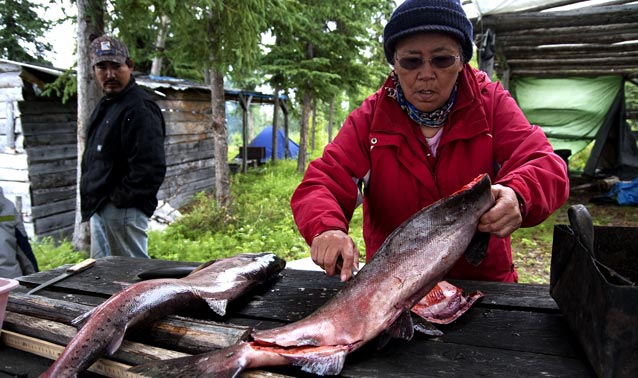
NPS Photo / Neil Blake
The Upper Kuskokwim River lies on the Northwestern side of the Alaska Range. The Athabascan people who live there are called Upper Kuskokwim Athabascans. They have traditionally used lands, now enclosed in the boundaries of the Park, as traditional hunting, trapping and gathering grounds for thousands of years. The language they speak is Dinak’i (Duh-naa-kuh). Their name for Denali is Denaze. Because they are people who have inhabited this land long before there was a National Park here, Denali Park and Preserve has awarded one of the villages, Telida, a two year grant to help them continue an Upper Kuskokwim River regional place names project.
From time immemorial, the native peoples of Alaska have systemically named places, or geomorphic features with names. The names could be descriptions, The Upper Kuskokwim River is named Dichinanek’, which means “river of sticks, trees.” Lake Minchumina means “lake big lake.” They may name a place to remember what happens there, the Trimokish Hills (North Peak) are named Tr’emo K’esh, which means “lonely or sad birch” which may speak of a place where cremations took place. They may explain what is found there, Big River is called, Izdlaghe Zighash No’, which means “Sheefish harvest river.” They may give direction as to what you do there, Nenots’eshts’ilyash hw, means “where we leave canoes” because the water gets too shallow and you have to proceed on foot.
These names were passed on orally though the ages so that the people of future generations would be able to find their way as they traversed the land, rivers, mountains, hills, portages and lakes. Some names are so old that there is no one living that knows the meaning of the name, but because of oral tradition, they know where the site is located.
Documenting these names is an invaluable part of the Athabascan culture, as the English names are now known more widely while the Dinak’i names are being lost. To date, almost 800 names have been mapped (geo-referenced) almost 800 names. The project team has “discovered” audio recordings of wise Elders who have since passed on, that recorded their travel stories throughout the Upper Kuskokwim River region and into the Alaska Range, as well as trade with the peoples on the southern side of the Alaska range. Some of these travel narratives are so informative that it is possible to retrace their steps. Once the team has collected and translated all that is possible, the Park will compile this information into a book for the Upper Kuskokwim Peoples, as well as create a kiosk in the Park’s Visitor Center.
Last updated: October 27, 2021
